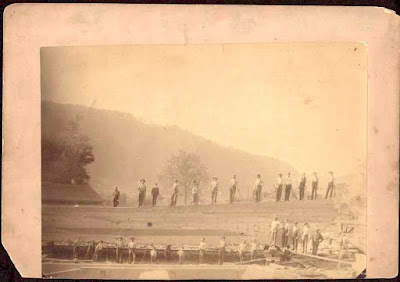Ship Builders Schooner Hull Cabinet Card c1880
Ship Builders Schooner Hull Cabinet Card c1880
From my blog archives
This particular image is a Cabinet Card that holds more than it appears to. On the surface, it's a rare image of a ship under construction. On close examination, things get fuzzy. First off, there are two small triangular black areas at the bottom left and right hand corners. These tell me that this is an Albumen photograph (a photograph made with egg white, no bacon please) of a Tintype photograph (no tin, just a sheet of iron with a collodion coating... go figure). It was not uncommon for photographers to make copies of earlier images either for resale or by request. The Tintype would have been a full-plate, a rarity in and of itself. Most Tintypes that we see are actually sections of the full plate. Cost was a factor as well as the work involved in producing the larger image. Most full-plate or half-plate Tintypes are outdoor scenes.
Back to this image. While found in New England, identifying this image is difficult. It could be from most anywhere. I don't know much about ship design, so that compounds the problem. Sometimes you can go by the clothes people are wearing, but in the case of the average worker, it is doubtful that people bought the latest fashions for wear while building a hull. My current guess is somewhere in the 1880's but I could be off by a decade. The image is of a clearly hilly or even mountainous region so that leaves Florida out of the running. No palm trees either. The hull is made up of some very substantial timbers, so I assume that this is a heavily forested area too.
On the rear of this Cabinet Card is stamped "R. W. Heilmann, Artist". Apparently an artist who labored in obscurity as I have not yet found his name referenced anywhere.
And that's just part of why I like old photographs. The detective work in identifying the image is a challenge and a joy. Sometimes we get lucky and there are identifying marks but usually it's a lot of educated guesswork. So if you have any good educated guesses, or recognize the hull or even someone in the photograph... drop me a line and I'll add your comments to the Toolemera Press.

Comments